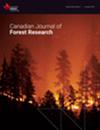用于改进中国东北森林生态系统中 33 种林下树种地上生物量估算的特定树种异速方程和广义异速方程
IF 1.5
3区 农林科学
Q2 FORESTRY
引用次数: 0
摘要
林下小乔木和灌木在森林生态系统的生物地球化学循环中发挥着至关重要的作用。然而,由于可用的异速生长方程数量有限,它们在中国东北地区的生物量仍不确定,并被严重忽视。本研究采用破坏性方法获得了 33 个物种的 782 株植株,并利用加权非线性似非相关回归方法,根据颈圈直径(D)和高度(H)建立了物种特异性和通用的地上部分异速生物量方程。结果表明,仅用 D 就能很好地预测每个生物量成分,R2 adj 值大多大于 0.80。当 H 作为 D2H 时,大多数物种在木质部和地上生物量模型中的表现更好。此外,这两个成分的广义方程显示出相对较大的变异系数(CV),但与物种特异性方程的偏差(Bias)相当,特别是对小树而言。建议只有在特定地点没有树种特定方程时,才使用混合树种的广义方程估算生物量。不过,如果精度不是主要考虑因素,也建议使用通用方程。所建立的方程将有助于提高中国东北森林生态系统林下木本植物生物量评估的准确性。本文章由计算机程序翻译,如有差异,请以英文原文为准。
Species-specific and generalized allometric equations for improving aboveground biomass estimations of thirty-three understory woody species in northeastern China forest ecosystems
Understory small trees and shrubs play a crucial role in the biogeochemical cycles in forest ecosystems. However, their biomass in northeastern China is still uncertain and has been heavily disregarded due to the limited number of available allometric equations. For this study, 782 plants from 33 species obtained by destructive method were used to develop species-specific and generalized aboveground allometric biomass equations based on collar diameter (D) and height (H) using weighted nonlinear seemingly unrelated regression. Each biomass component was shown to be well predicted by D alone, with R2 adj values mostly greater than 0.80. The majority of species performed better in the models for wood and aboveground biomass when H was included as D2H. Furthermore, generalized equations for the two components showed a comparatively large coefficient of variation (CV) but comparable Bias to species-specific equations, espe-cially for small trees. It is recommended to estimate biomass using generalized equations for mixed species only when species-specific equations are unavailable at a given site. However, in the event when precision is not the primary con-cern, generalized equations are also suggested. The developed equations will help to improve the accuracy of biomass assessment of understory woody plants in northeastern China forest ecosystems.
求助全文
通过发布文献求助,成功后即可免费获取论文全文。
去求助
来源期刊
CiteScore
4.20
自引率
9.10%
发文量
109
审稿时长
3 months
期刊介绍:
Published since 1971, the Canadian Journal of Forest Research is a monthly journal that features articles, reviews, notes and concept papers on a broad spectrum of forest sciences, including biometrics, conservation, disturbances, ecology, economics, entomology, genetics, hydrology, management, nutrient cycling, pathology, physiology, remote sensing, silviculture, social sciences, soils, stand dynamics, and wood science, all in relation to the understanding or management of ecosystem services. It also publishes special issues dedicated to a topic of current interest.

 求助内容:
求助内容: 应助结果提醒方式:
应助结果提醒方式:


